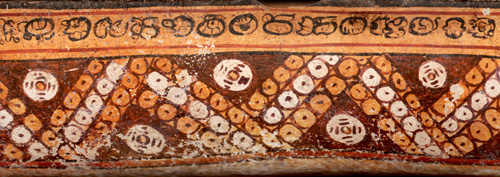Hieroglyphics
The decipherment of Mayan hieroglyphic writing and the ability of linguists and epigraphers to read the ancient phonetic aspects of Mayan hieroglyphs in the original Mayan languages has resulted in a worldwide interest in Mayan glyphs. Weekend hieroglyphic workshops take place all over the world, from Palenque, Mexico to Copenhagen, Denmark. The best known Mayan hieroglyphic workshop is that organized by Linda Schele for the University of Texas. After her untimely demise her work is carried on by the capable German epigrapher Professor N. Grube. The University of Pennsylvania and many other colleges have also organized weekend hieroglyphic workshops.
The F.L.A.A.R. Photo Archive includes countless photographs of Mayan hieroglyphic inscriptions. Many of these photographs have been used by leading epigraphers. In 1996 and 1997 F.L.A.A.R. organized two weekend hieroglyphic workshops together with epigrapher Dr Barbara MacLeod. The style-dating, regional style classification, and iconography of the glyphs was presented by Dr Nicholas Hellmuth. The linguistics and phonetic readings were discussed by MacLeod.
 |
| Chama bowl with hieroglyph, Museo Popol Vuh |
Aided by donations from lay people who are interested in furthering the study of Mayan hieroglyphic writing, it has been possible for F.L.A.A.R. to digitatize several thousand hieroglyphs from the negatives and slides of the Photo Archive. In addition, F.L.A.A.R. worked together with epigrapher and linguist Dr Yoshiho Yasugi to photograph all the Mayan hieroglyphic inscriptions which could be found on Maya vases, bowls, and plates in all the museums and private collections throughout Japan. This material is now being prepared for publication and we can show some samples.
Ancient writing systems always seem to attract attention, especially scripts which defy decipherment. Up until perhaps the 1960's only the calendrical and mathematical hieroglyphs could be read, based on studies of glyphic inscriptions from the Maya codices and monumental sculpture. Today a larger percentage and wider range of subjects can be understood. Since most of the glyphs on stone stelae can already be read, the new frontier is the decipherment of glyphs on pottery. Here F.L.A.A.R. has an advantage, since the Photo Archive includes so many thousands of photographs of vases, plates, and bowls which are not widely known outside of this archive. Naturally such a mass of material includes many glyphs. If adequate money were donated or provided in grants we could prepare and present the entire corpus of glyphs rather quickly, but since funding is scarce, we do our best to provide texts in our books. "Tikal Copan" actually included a number of hieroglyphs on pottery as did "Monster and Men." Now we are preparing the newest monograph and it will include many more inscriptions, all from vases, bowls, and plates. Most of these Mayan hieroglyphic texts have not previously been published elsewhere.
In 1997 the F.L.A.A.R. photo crew spent six months in Guatemala doing extensive photography. This project included doing rollout photographs of a multitude of vases and bowls which had hieroglyphic inscriptions. In addition to the traditional Primary Standard Sequence (PSS) of Peten style pottery, this photography program also recorded as many hieroglyphic inscriptions from Chama pots as was possible to locate. We show one here. Shortly we will be reproducing the most remarkable discovery of this project, an entire Chama bowl completely filled with three rows of hieroglyphs. This is the longest hieroglyphic text yet found on a Chama vase or bowl and probably the longest hieroglyphic inscription ever found on any Highland Guatemalan pot of any style. This unusual Chama text is not a PSS and, as typical for Chama inscriptions, includes many repeats.
Although Chama art is best known for its diagnostic black and white chevrons, actually the typical Chama bands do not have to be in chevron shape. Below we picture a section of a rollout of one panel from a low Chama bowl with rectangular banding.
 |
Usually these vessels are found in the Maya lowlands and correspond to the ceramic sphere Tepeu 1. |
 |
|
These rollouts were taken by the FLAAR team at the Museo Popol Vuh in Guatemala. The rollout images provide a complete vision of the scenes and glyphic texts which facilitates the analysis for epigraphers. |
New page format posted November 17, 2009.
